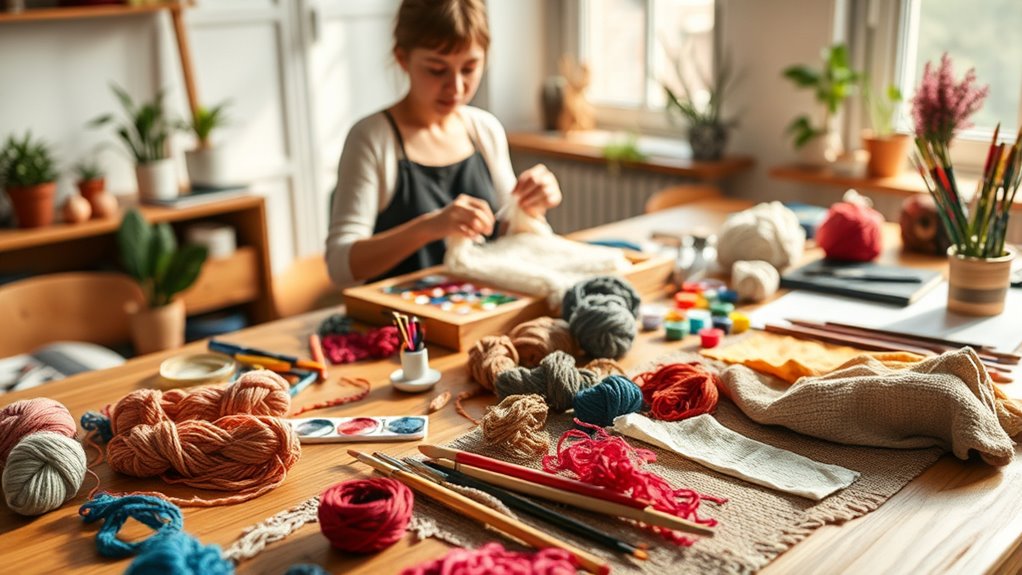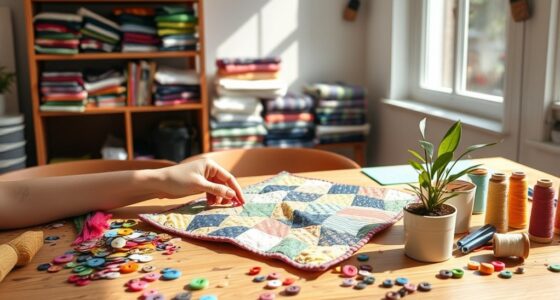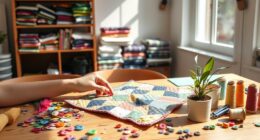Engaging in crafting activities is proven to boost your mental health by reducing stress, improving mood, and fostering emotional resilience. It serves as a form of art therapy, encouraging mindfulness and emotional regulation. Completing projects gives you a sense of achievement and boosts self-esteem. Plus, joining craft groups helps you connect with others, reducing loneliness. If you want to uncover more about these scientifically supported benefits, you’re in the right spot to discover how crafting can support your well-being.
Key Takeaways
- Crafting enhances mood, reduces stress, and serves as art therapy, aiding emotional expression and resilience.
- Engaging in craft activities promotes mindfulness and emotional regulation by fostering present-moment awareness.
- Completing projects boosts self-esteem, sense of achievement, and confidence, supporting emotional well-being.
- Participating in crafting communities fosters social connections, reducing loneliness and improving mental health.
- Evidence-based research recognizes crafting as a therapeutic activity that nurtures emotional balance and resilience.

Have you ever noticed how focusing on a simple craft can lift your mood and clear your mind? Engaging in crafting activities isn’t just about making something pretty; it’s a powerful tool for improving your mental health. Many people turn to art therapy because it offers a safe space to express feelings without words. When you create, you tap into your emotions and process them more effectively, helping to build emotional resilience. This resilience isn’t just about bouncing back from setbacks but developing a stronger sense of stability even during tough times. Crafting provides a tangible way to channel your emotions, which can ease anxiety, depression, and stress.
Focusing on simple crafts boosts mood, eases stress, and builds emotional resilience through creative expression.
As you pick up your supplies—whether it’s knitting, painting, or scrapbooking—you’re engaging your brain in a mindful activity that pulls you into the present moment. This mindfulness reduces ruminative thinking and helps you detach from negative thought patterns. Over time, this consistent focus can reshape how you respond to stress, making you more adaptable and emotionally resilient. Art therapy, in particular, emphasizes the process of creation rather than the end product, allowing you to explore your feelings without judgment. This process encourages self-awareness and self-compassion, both indispensable for mental well-being. When you use crafts as a form of art therapy, you’re fundamentally practicing emotional regulation, which is key to maintaining mental health.
Moreover, crafting can serve as a healthy distraction, giving your mind a break from worries and intrusive thoughts. It fosters a sense of accomplishment, which can boost your self-esteem and foster positive emotions. When you see a project come to life through your effort, you feel more capable and confident. This sense of achievement reinforces your emotional resilience, helping you face future challenges with a stronger mindset. The social aspect of crafting can also contribute to mental health. Joining a crafting group or sharing your work online creates a sense of community and belonging, which are essential components of emotional resilience. Feeling connected and supported can lessen feelings of loneliness and isolation, further enhancing your mental well-being.
Inherently, crafting isn’t just a hobby; it’s an evidence-backed activity that nurtures your mental health. It offers a therapeutic outlet for emotions, cultivates resilience, and promotes mindfulness—all indispensable for maintaining emotional balance. Additionally, engaging in activities like color calibration can further enhance the visual experience and contribute to a sense of control and satisfaction in your crafting projects. When you make time for crafting, you’re investing in your mental health, creating a space where healing, growth, and self-expression can flourish.
Frequently Asked Questions
How Does Crafting Compare to Other Mental Health Therapies?
Compared to other mental health therapies, crafting offers unique benefits through creative expression and social connection. It actively engages you in a hands-on activity that reduces stress and enhances mood. Unlike talk therapies, crafting allows you to communicate feelings without words, fostering emotional release. The social aspect also helps build support networks, making it a valuable complementary approach to traditional treatments. Overall, crafting empowers you to improve mental well-being in a personalized, engaging way.
Are There Specific Crafts Best Suited for Mental Health Improvement?
You might wonder if certain crafts are better for mental health. Coloring therapy is excellent for reducing stress and enhancing mindfulness, while knitting benefits include improving focus and providing a calming routine. Both activities allow you to stay present and express creativity, making them particularly effective. Try coloring or knitting to see how these specific crafts can boost your mental well-being and offer a soothing, productive outlet.
How Often Should One Engage in Crafting for Optimal Benefits?
Did you know that engaging in creative activities just twice a week can considerably reduce stress? For ideal benefits, aim for a regular crafting frequency of at least 2-3 times weekly. This consistent engagement helps maintain mental clarity and emotional well-being. Don’t overthink it—find a rhythm that fits your schedule so you can enjoy the mental health perks of crafting without feeling overwhelmed.
Can Crafting Help With Severe Mental Health Conditions?
You might wonder if crafting can help with severe mental health conditions. While it’s not a cure, engaging in crafting provides sensory stimulation and promotes emotional regulation, which can alleviate some symptoms. By focusing on your project, you may find relief from overwhelming feelings and develop a sense of accomplishment. Keep in mind, though, it’s best to combine crafting with professional treatment for holistic mental health support.
What Are the Potential Risks or Downsides of Crafting for Mental Health?
You might worry about burnout risks or crafting dependency when using crafting as a mental health tool. Overdoing it can lead to burnout, making you feel exhausted or stressed rather than relaxed. Plus, you could become overly dependent on crafting for comfort, avoiding other important activities or social interactions. It’s important to balance crafting with other coping strategies and set healthy boundaries to prevent these potential downsides.
Conclusion
By picking up a craft, you’re planting seeds of calm and resilience in your mind’s garden. Each stitch, brushstroke, or knot becomes a gentle wave washing over stress, nurturing your well-being. Remember, crafting isn’t just a hobby—it’s a lifeline that wraps around you like a warm blanket on a cold day. So, immerse yourself and let your creativity bloom, turning simple materials into powerful tools for your mental health.









